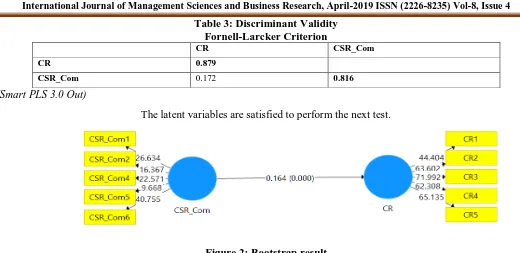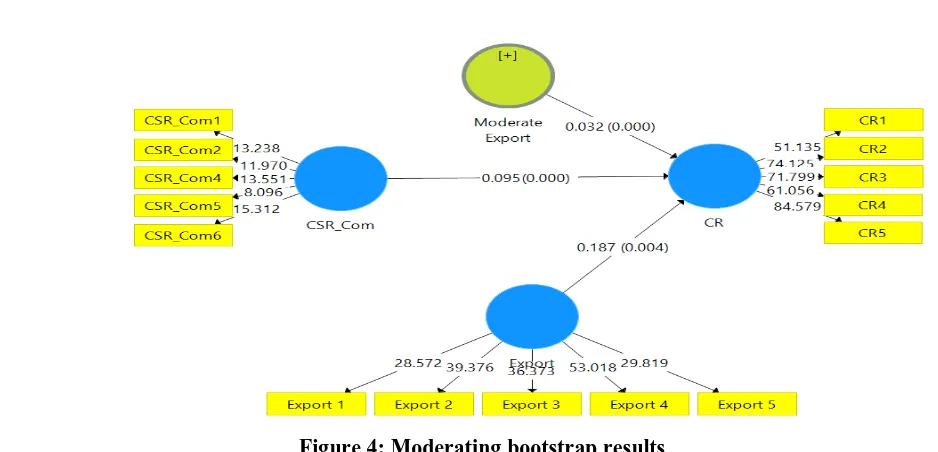The Impact of CSR Community to Reputation of Vietnamese Textile and Garment
Enterprises Moderating Role of Export Products Rate
Author’s Details:
(1)
Thi Hong Hanh Le-University of Economic and Technical Industries
(2)
Thi Thu Hien Phan, MA-University of Economic and Technical Industries
Correspondence: Thi Thu Hien Phan No. 296/61/12 Linh Nam Street, Hoang Mai District, Hanoi, Vietnam
Abstract:
The purpose of the study is to test the impact of corporate social responsibility with the community (CSR_com) on corporate reputation. At the same time, we evaluate the moderating role of the export products rate in the relationship between CSR_Com and corporate reputation of Vietnamese textile enterprises. The study was conducted on 389 Vietnamese textile and garment enterprises named in the "Vietnam textile and garment directory" issued by the Vietnam Textile and Apparel Association in 2015. The results showed that CSR_Com positively affected corporate reputation and the proportion of export products that play a moderating role in the relationship between CSR_Com and corporate reputation is significant
Keywords: Corporate social responsibility, corporate reputation, export products rate, textile, and garment, Vietnam.
1. Introduction
In the context of the industrial revolution 4.0, the economy is deeply integrated, in order to survive and develop Vietnamese enterprises in general and textile enterprises in particular need to actively update the world's standards, including corporate social responsibility (CSR) standards. Many corporates have known CSR, every year VCCI often organizes social enterprise awards for Vietnamese businesses that contribute to the sustainable development of society.
The textile and garment industry is a key economic sector of the countries; annually the textile and garment industry contributes about 15% to GDP and creates jobs for about 3 million workers, accounting for 5% of the total labor force of the country. Export turnover in 2018 of Vietnam textile and garment industry is 31 billion USD.
CSR activities of textile enterprises are very important; CSR is considered a "passport" for Vietnamese textile enterprises to reach the world market. CSR activities are conditions for Vietnamese textile enterprises to sign orders with famous brands such as Nike, HM, Zara, etc. CSR activities with local communities help Vietnamese textile enterprises Create reputation with international customers and gradually improve the efficiency of production and business activities of enterprises.
In addition to the research introduction, the article includes Research overview and research hypotheses; Research Methods; Research results and conclusions.
2. Literature review and research hypotheses
2.1. CSR, CSR community
McWilliams et al. (2006) argue that CSR consists of four aspects as follows: “CSR activities have been included including combining social characteristics or social features into product and production processes. export (eg, aerosol products without fluorocarbons or using environmentally friendly technology), applying progressive human resource management measures (for example, promoting employee empowerment) level environmental performance through recycling and pollution reduction (for example, applying a positive stance on reducing emissions), and promoting community organizational goals (for example, working closely with community-based organizations ”(McWilliams et al., 2006, page 3). According to Mirsha and Suar (2010), CSR is voluntary activities of enterprises to ensure the interests of stakeholders such as employees, communities, environment, suppliers, customers, investors. In this study, we approached CSR from the perspective of Mirsha and Suar (2010).
Based on the inheritance of Mirsha and Suar (2010), the author provides CSR activities / policies for the community including the following:
1. Policy to participate in charitable activities to help the community
2. Policy to support initiatives related to sustainable social development
3. Long-term social responsibility policies
4. Policy to maintain partnerships with organizations that work for social purposes
5. Policies to fully comply with obligations to the state
6. Policy prohibiting the use of child labor and prohibiting human rights violations
2.2. The relationship between CSR community and corporate reputation
Many benefits of CSR have been identified. First, brand image and reputation are higher in companies that perform CSR activities compared to non-performing companies or socially irresponsible companies (Jenkins 2006). Tsoutsoura (2004) has shown that some CSR plans can reduce a company's operating costs. For example, a CSR goal is to reduce environmental pollution; This can be achieved by implementing simple measures such as reducing package materials and planning the optimal routes for delivery trucks. This is a strong incentive for companies to increase their CSR activity. Second, socially responsible companies have less risk of negative events. Turban and Greening (1997) argue that strong CSR commitment increases the ability to attract and retain employees. Third, CSR practices lead to increased productivity and reduced error rates (Tsoutsoura 2004). As mentioned earlier, these advantages relate to CSR practices for stakeholders such as employees, customers, and the community. Stakeholder pressure is the main reason for implementing CSR; therefore, these benefits are related to the satisfaction of stakeholders. For example, increasing productivity results from improved working conditions and labor practices (Tsoutsoura 2004). Brand image and reputation are an advantage for companies that allow them to increase access to capital and their trading partners. Another advantage that motivates businesses to implement CSR is to attract and retain employees, and thus labor rotation costs include: recruitment, training, and development significantly reduced. Since then we proposed the hypothesis:
H1: CSR Community has a positive impact on corporate reputation
2.3. The moderating role of export product ratio
According to Lee and Jung (2015), product differentiation regulates the impact of CSR on the enterprise's competitive advantage and performance. For Vietnamese textile enterprises, business activities are mainly carried out by orders of foreign customers. Therefore, the biggest difference between Vietnamese textile enterprises is the proportion of exported products. The more exporting enterprises, the more CSR activities are concerned, including community CSR. For businesses with a high proportion of export products, they attach great importance to the reputation for their reputation of determining the quantity and quality of their orders and directly impacting their performance. As for domestic consumption enterprises, community CSR activities are few and have little impact on consumers' intention to buy goods. Therefore, we propose a hypothesis:
H2: The rate of export products plays a moderating role in the relationship between CSR community and corporate reputation
3. Research methods
3.1. Sample of research
3.2. Research models
Figure 1: Research model
To conduct data analysis and test research hypotheses, we use SPSS 22 software to test scale reliability. After that, we conducted the analysis using Smart PLS 3.0 software to test hypotheses.
The independent CSR community variable was developed from the study of Mirsha and Suar (2010), the CSR community consists of 6 iterms. The dependent variable Corporate reputation was developed from the research of Roberts and Dowling, (2002); Galbreath, 2010) consists of 5 iterms.
4. Research results
Before conducting analysis with Smart PLS 3.0 software, we conducted the reliability test for two potential variables by SPSS 22 software. The result is a scale of CSR_Com3 with Cronbach Alpha coefficient <0.6, so we removed the analysis model. The remaining data we analyzed on Smart PLS 3.0 is as follows:
Results of verification of the reliability of scale:
Table 1: Outer Loadings
CR CSR_Com
CR1 0.821
CR2 0.819
CR3 0.958
CR4 0.991
CR5 0.787
CSR_Com1 0.886
CSR_Com2 0.691
CSR_Com4 0.796
CSR_Com5 0.619
CSR_Com6 0.838
(Smart PLS 3.0 Out)
Outer loadings result shows that all of the scales have outer loading> 0.5 so that the conditions for analysis are satisfied.
Table 2: Construct Reliability and Validity
Cronbach's Alpha rho_A Composite Reliability Average Variance Extracted (AVE)
CR 0.945 0.951 0.944 0.773
CSR_Com__ 0.911 0.962 0.903 0.667
(Smart PLS 3.0 Out)
The test of Composite reliability and Cronbach Alpha all satisfy the condition. Composite Reliability >0.5, Cronbach Alpha > 0.7 và AVE >0.5.
Export
CSR_ Com Corporate
Table 3: Discriminant Validity Fornell-Larcker Criterion
CR CSR_Com
CR 0.879
CSR_Com 0.172 0.816
(Smart PLS 3.0 Out)
The latent variables are satisfied to perform the next test.
Figure 2: Bootstrap result
The above results show that CSR_Com has a statistically significant direct impact on the reputation of enterprises with an average impact coefficient of 0.164 at 1% significance level with P - value = 0.000. Thus, the more Vietnamese garment enterprises implement CSR with the community, the better their reputation. CSR helps improve the image, brand, and reputation of Vietnamese textile enterprises.
The next step is to test the regulatory role of the "export product ratio." Textile enterprises with a high proportion of export products often perform CSR better and more voluntarily. So does this make the reputation of these businesses better?
Figure 3: Model of checking the moderating role of Export
Figure 4: Moderating bootstrap results
The results show that the proportion of regulatory products that play a statistically significant role in the relationship between community CSR and the reputation of enterprises with standardized numbers is 0.032 at 1% significance level. From this impact coefficient, we model as follows:
Figure 5: Moderating role of Export
The analytical results show that the higher the export of enterprises, the greater the impact of CSR on the reputation, and the lower the ratio of export products to the impact of community CSR on reputation. less than high export enterprises. Therefore, Vietnamese textile and apparel enterprises should implement CSR community to improve their reputation thereby improving business performance.
5. Conclusion
The relationship between CSR and the reputation of the business has been interested and implemented by many researchers. These studies are often concentrated in developed countries with high institutions and high consumer understanding. In countries with developing economies like Vietnam, there are still quite limited studies on this topic. Through the results of our research, we hope to enrich the theory of CSR and help Vietnamese textile enterprises confidently implement CSR. The research results show that community CSR has a positive impact on the reputation of enterprises, which is similar to the research results of Saedei et al. (2015).
i. Agyemang, O., & Ansong, A. (2017). Corporate social responsibility and firm performance of Ghanaian SMEs Mediating role of access to capital and firm reputation . Journal of Global Responsibility, Vol. 8 No. 1, pp. 47-62. ii. Aras, G., Aybars, A., & Kutlu, O. (2010). Management corporate performance: investigating the relationship between corporate social responsibility and financial performance in emerging markets. International Journal of Productivity and Performance Management, Vol. 59 (3): 229-254.
iii. AREOLA, E. (2017). The Relationship of Corporate Social Responsibility and Financial Performance Under Corporate Governance Aspects in Selected Southeast Asian Companies. Schaan: PHD, The University of St. Gallen.
iv. Carroll, A. (1979). A three - demensional conceptual model of corporate performance. The Academy of Management, Vol. 4, Pp. 497 - 530.
v. Famiyeh, S. (2017). Corporate social responsibility and firm's performance: empirical evidence. Social Responsibility Journal, Vol. 13, Iss. 2, pp. 390-406.
vi. Famiyeh, S., Kwarteng, A., & Dadzie, S. (2016). Corporate social responsibility and reputation: some empirical perspectives. Journal of Global Responsibility, Vol. 7, Iss. 2, Pp. 258-274.
vii. Fauzi , H., & Idris, K. (2009). The Relationship of CSR and Financial Performance: New Evidence from Indonesian. Issues in Social and Environmental Accounting, Vol. 3, No. 1 Pp. 66-87.
viii. Galbreath, J. (2010). How does corporate social responsibility benefit firms? Evidence from Australia. European Business Review, Vol. 22 No. 4 pp. 411-431.


